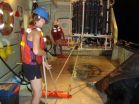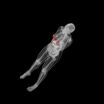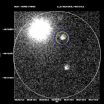(Press-News.org) In a discovery decades in the making, scientists have detected the first of a "theoretical" class of stars first proposed in 1975 by physicist Kip Thorne and astronomer Anna Żytkow. Thorne-Żytkow objects (TŻOs) are hybrids of red supergiant and neutron stars that superficially resemble normal red supergiants, such as Betelguese in the constellation Orion. They differ, however, in their distinct chemical signatures that result from unique activity in their stellar interiors.
TŻOs are thought to be formed by the interaction of two massive stars―a red supergiant and a neutron star formed during a supernova explosion―in a close binary system. While the exact mechanism is uncertain, the most commonly held theory suggests that, during the evolutionary interaction of the two stars, the much more massive red supergiant essentially swallows the neutron star, which spirals into the core of the red supergiant.
While normal red supergiants derive their energy from nuclear fusion in their cores, TŻOs are powered by the unusual activity of the absorbed neutron stars in their cores. The discovery of this TŻO thus provides evidence of a model of stellar interiors previously undetected by astronomers.
Project leader Emily Levesque of the University of Colorado Boulder, who earlier this year was awarded the American Astronomical Society's Annie Jump Cannon Award, said, "Studying these objects is exciting because it represents a completely new model of how stellar interiors can work. In these interiors we also have a new way of producing heavy elements in our universe. You've heard that everything is made of 'star stuff'—inside these stars we might now have a new way to make some of it."
The study, accepted for publication in the Monthly Notices of the Royal Astronomical Society Letters, is co-authored by Philip Massey, of Lowell Observatory in Flagstaff, Arizona; Anna Żytkow of the University of Cambridge in the U.K.; and Nidia Morrell of the Carnegie Observatories in La Serena, Chile.
The astronomers made their discovery with the 6.5-meter Magellan Clay telescope on Las Campanas, in Chile. They examined the spectrum of light emitted from apparent red supergiants, which tells them what elements are present. When the spectrum of one particular star—HV 2112 in the Small Magellanic Cloud―was first displayed, the observers were quite surprised by some of the unusual features. Morrell explained, "I don't know what this is, but I know that I like it!"
When Levesque and her colleagues took a close look at the subtle lines in the spectrum they found that it contained excess rubidium, lithium and molybdenum. Past research has shown that normal stellar processes can create each of these elements. But high abundances of all three of these at the temperatures typical of red supergiants is a unique signature of TŻOs.
"I am extremely happy that observational confirmation of our theoretical prediction has started to emerge," Żytkow said. "Since Kip Thorne and I proposed our models of stars with neutron cores, people were not able to disprove our work. If theory is sound, experimental confirmation shows up sooner or later. So it was a matter of identification of a promising group of stars, getting telescope time and proceeding with the project."
The team is careful to point out that HV 2112 displays some chemical characteristics that don't quite match theoretical models. Massey points out, "We could, of course, be wrong. There are some minor inconsistencies between some of the details of what we found and what theory predicts. But the theoretical predictions are quite old, and there have been a lot of improvements in the theory since then. Hopefully our discovery will spur additional work on the theoretical side now."
INFORMATION: END
Astronomers discover first Thorne-Zytkow object, a bizarre type of hybrid star
2014-06-04
ELSE PRESS RELEASES FROM THIS DATE:
How red tide knocks out its competition
2014-06-04
New research reveals how the algae behind red tide thoroughly disables – but doesn't kill – other species of algae. The study shows how chemical signaling between algae can trigger big changes in the marine ecosystem.
Marine algae fight other species of algae for nutrients and light, and, ultimately, survival. The algae that cause red tides, the algal blooms that color blue ocean waters red, carry an arsenal of molecules that disable some other algae. The incapacitated algae don't necessarily die, but their growth grinds to a halt. This could explain part of why blooms ...
New diagnostic imaging techniques deemed safe in simulations
2014-06-04
DURHAM, N.C. -- Gamma and neutron imaging offer possible improvements over existing techniques such as X-ray or CT, but their safety is not yet fully understood. Using computer simulations, imaging the liver and breast with gamma or neutron radiation was found to be safe, delivering levels of radiation on par with conventional medical imaging, according to researchers at Duke Medicine.
The findings, published in the June issue of the journal Medical Physics, will help researchers to move testing of gamma and neutron imaging into animals and later humans.
Conventional ...
Study: When hospital workers get vaccines, community flu rates fall
2014-06-04
Anaheim, Calif., June 4, 2014 – For every 15 healthcare providers who receive the influenza vaccination, one fewer person in the community will contract an influenza-like illness, according to a study using California public health data from 2009 – 2012.
In an abstract that will be presented on June 7 at the 41st Annual Conference of the Association for Professionals in Infection Control and Epidemiology (APIC), a researcher analyzed archival data from the California Department of Public Health to determine the relationship between vaccinating healthcare personnel against ...
MU scientists successfully transplant, grow stem cells in pigs
2014-06-04
COLUMBIA, Mo. – One of the biggest challenges for medical researchers studying the effectiveness of stem cell therapies is that transplants or grafts of cells are often rejected by the hosts. This rejection can render experiments useless, making research into potentially life-saving treatments a long and difficult process. Now, researchers at the University of Missouri have shown that a new line of genetically modified pigs will host transplanted cells without the risk of rejection.
"The rejection of transplants and grafts by host bodies is a huge hurdle for medical researchers," ...
Saturated fat intake may influence a person's expression of genetic obesity risk
2014-06-04
Boston, MA (June 4, 2014) ─ Limiting saturated fat could help people whose genetic make-up increases their chance of being obese. In a new study, researchers from the Jean Mayer USDA Human Nutrition Research Center on Aging (USDA HNRCA) at Tufts University identified 63 gene variants related to obesity and used them to calculate a genetic risk score for obesity for more than 2,800 white, American men and women enrolled in two large studies on heart disease prevention. People with a higher genetic risk score, who also consumed more of their calories as saturated fat, ...
Ice cream sensations on the computer
2014-06-04
Changes in coldness, creaminess or texture that we experience in the mouth while we are eating an ice cream can be visualised on a screen using coloured curves. Graphs help manufacturers improve product quality, as proven by researchers at the Institute of Agrochemistry and Food Technology in Valencia, Spain.
In the last five years a technique known as 'Temporal Dominance of Sensations' (TDS) has become popular, used to analyse how consumer impressions evolve from the moment they taste a product.
Researchers at the Institute of Agrochemistry and Food Technology (CSIC) ...
Weight loss surgery also safeguards obese people against cancer
2014-06-04
Weight loss surgery might have more value than simply helping morbidly obese people to shed unhealthy extra pounds. It reduces their risk of cancer to rates almost similar to those of people of normal weight. This is the conclusion of the first comprehensive review article taking into account relevant studies about obesity, cancer rates and a weight loss procedure called bariatric surgery. Published in Springer's journal Obesity Surgery, the review was led by Daniela Casagrande of the Universidade Federal do Rio Grande do Sul in Brazil.
With bariatric surgery, a part ...
Observed by Texas telescope: Light from huge explosion 12 billion years ago reaches Earth
2014-06-04
Intense light from the enormous explosion of a star more than 12 billion years ago — shortly after the Big Bang — recently reached Earth and was visible in the sky.
Known as a gamma-ray burst, light from the rare, high-energy explosion traveled for 12.1 billion years before it was detected and observed by a telescope owned by Southern Methodist University, Dallas.
Gamma-ray bursts are believed to be the catastrophic collapse of a star at the end of its life. SMU physicists report that their telescope was the first on the ground to observe the burst and to capture an ...
A new approach to diversity research
2014-06-04
When people work in socially homogeneous groups, they overestimate their own contributions to the group's success, according to a new study co-authored by an MIT scholar. In fact, in some cases such "self-serving bias" occurs to a degree about five times as great in homogeneous groups as in ethnically diverse groups.
Such results raise a larger point, suggests Evan Apfelbaum, the W. Maurice Young Assistant Professor of Organization Studies at the MIT Sloan School of Management, and the lead author of the new study: Researchers have often used homogeneous social groups ...
NASA should maintain long-term focus on Mars as 'horizon goal' for human spaceflight
2014-06-04
WASHINGTON – Arguing for a continuation of the nation's human space exploration program, a new congressionally mandated report from the National Research Council concludes that the expense of human spaceflight and the dangers to the astronauts involved can be justified only by the goal of putting humans on other worlds. The report recommends that the nation pursue a disciplined "pathway" approach that encompasses executing a specific sequence of intermediate accomplishments and destinations leading to the "horizon goal" of putting humans on Mars. The success of this approach ...




